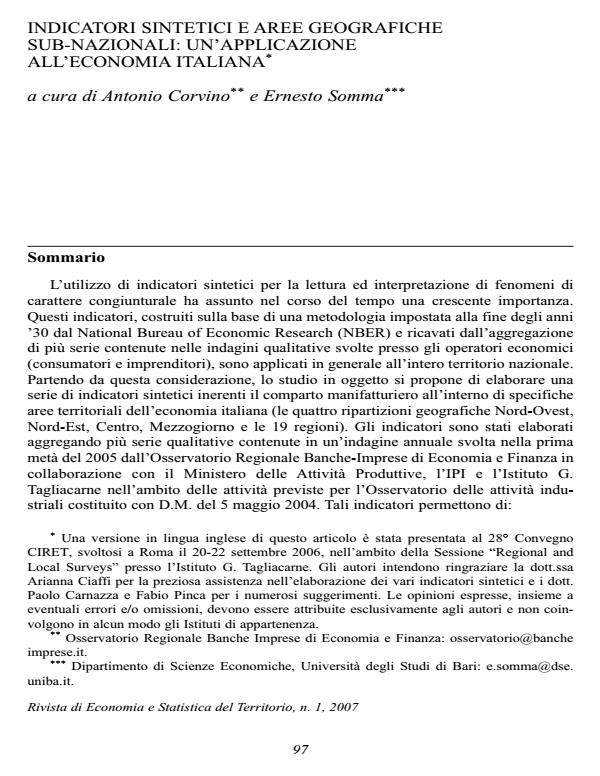Indicatori sintetici ed aree geografiche sub-nazionali: un'applicazione all'economia italiana
Journal title RIVISTA DI ECONOMIA E STATISTICA DEL TERRITORIO
Author/s Antonio Corvino, Ernesto Somma
Publishing Year 2008 Issue 2007/1
Language Italian Pages 21 P. 97-117 File size 194 KB
DOI
DOI is like a bar code for intellectual property: to have more infomation
click here
Below, you can see the article first page
If you want to buy this article in PDF format, you can do it, following the instructions to buy download credits

FrancoAngeli is member of Publishers International Linking Association, Inc (PILA), a not-for-profit association which run the CrossRef service enabling links to and from online scholarly content.
Objectives The use of synthetic indicators for the reading and interpretation of phenomena of economic character has assumed during the time an increasing importance. These indicators, built on the base of a specific methodology planned at the end of the thirties by National Bureau of Economic Research (NBER) and obtained from the aggregation of more series contained in the qualitative surveys carried out among the economic operators (consumers and entrepreneurs), are applied to the whole national territory. Methods and Results Starting from this consideration, the survey in object intends to elaborate a series of synthetic indicators concerning the manufacturing compartment and the ICT inside specific territorial areas of Italian economy (the four main geographical divisions: North West, North East, Center, Midday and the Nineteen Regions). These indicators have been elaborated combining more qualitative series contained in an annual survey developed in the first half of the year 2005 by the Regional Observatory Bankenterprises of Economy and Finance in collaboration with the Office of the Productive Activities, the IPI and the Institute G.Tagliacarne within the anticipated activities for the Observatory of the Industrial Activities constituted with D.M. of May 5th, 2004. Such indicators allow: to compare the different performances of the enterprises inside the various territorial areas; to compile a classification of the regions; to analyze for three selected regions (Liguria, Sicily, Umbria), according to their positioning within the quoted classification, the behavior of separate macro-sectors. Conclusions In the conclusions, the survey puts in evidence both the principals merits and the limits of the adopted methodological approach and it underlines the necessity, for a more articulated and complete reading of the territory, to use jointly the synthetic indicators and other variables of quantitative and qualitative character.
Antonio Corvino, Ernesto Somma, Indicatori sintetici ed aree geografiche sub-nazionali: un'applicazione all'economia italiana in "RIVISTA DI ECONOMIA E STATISTICA DEL TERRITORIO" 1/2007, pp 97-117, DOI: